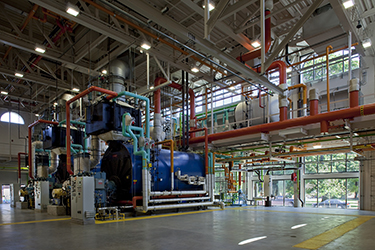|
Subscribe / Renew |
|
|
Contact Us |
|
| ► Subscribe to our Free Weekly Newsletter | |
| home | Welcome, sign in or click here to subscribe. | login |
Architecture & Engineering
| |
 |
October 30, 2014
Commissioning is key to a smooth running central utility plant
Wood Harbinger

Pitts
|

Higgs
|
A successfully completed project, with all building systems working at optimum efficiency: that’s the end result for which the whole project team strives from day one.
Commissioning is a widely recognized quality-assurance process that can ensure this goal becomes reality. If you have the right commissioning team for the job, that is.
There are stark differences between commissioning a stand-alone building, such as an office tower or even a research facility, and commissioning a central utility plant.
Generally used in university or medical campuses and large-scale production facilities, central utility plants are a collection of finely calibrated, critical systems, with highly customized and sophisticated operating criteria, connected to rest of the campus by an intricately coordinated distribution system. The commissioning exercise — and the choice of who will take on that challenge — become exponentially more critical due to the complex nature of the central utility plant.
Bringing a highly skilled commissioning team with extensive central utility plant experience into the project early on is an owner’s best bet for successful project completion and ongoing operation and maintenance benefit.
How do they work?
The central utility plant is the heart, lungs and brain of a multi-building entity; the origin of main source heating, cooling, power and other systems serving the primary needs of the campus. The distribution system, then, is the arteries, veins and nerves, branching out and connecting to every system, in every space, of every building.
The sheer scale and intricacy of the combined operation, coupled with the crucial nature of the spaces and systems often served, sets a central utility plant apart from any other application of MEP systems.
The challenge for the commissioning team lies in considering the entire perspective. It requires strong knowledge of the related distribution system, a deep understanding and experience with how the entire system integrates and operates together, and a honed ability to recognize the nuanced problems that will come up.
Expertise comes with experience, and since very few projects of such size and complexity as a central utility plant are built in the first place, there are limited chances for commissioning authorities, as well as designers, to gain experience. An engineering background and keen awareness of industry best practices, through high-level certifications like the Building Commissioning Association’s Certified Commissioning Professional credential, provide a solid foundation on which acute experience will build.
Leveraging the expertise of an experienced commissioning authority is a lucrative opportunity to help ensure ultimate project success.
Big picture and the details
With central utility plants, the devil is in the details. These great systems can be felled by a subtle misstep somewhere in the plant, in the distribution system, or in any one of the myriad systems it supports. A commissioning authority truly capable of placing the “big picture” in mind, while also possessing the precision required to focus on the details, can spot connections that aren’t always apparent or intuitive. This insight might be the difference between an expensive “fix” and a real solution. That distinction is invaluable to an owner.
During a recent startup of a 1.3 million-square-foot manufacturing facility, the commissioning team encountered recurring faults with the variable-speed drives for five parallel chilled water distribution pumps in the central utility plant.
Taking into account the distribution system’s routing of miles of piping beyond the plant, and conducting an investigation of the isolation and bypass valves throughout the system, they determined that the configuration of the distribution piping and the control software was forcing the pumps to operate beyond their range.
Think of a car trying to do 60 mph in first gear; it’s a recipe for disaster.
The commissioning authority worked with the designer to make simple changes to the pump staging and safety control software, which allowed the pumps to properly respond to any configuration of the distribution piping network. Having discovered the root cause of the problem rather than addressing just the apparent symptoms, this solution saved the owner from unnecessarily spending thousands of dollars replacing the five huge pumps, motors and drives.
The key to this success was familiarity with the size of the systems found in central utility plants and awareness of the entire, interconnected plant and distribution system; a familiarity that commissioning teams without direct central plant experience would lack.
Whether during design or during functional testing, there’s an art to discerning when an element will impede the plant’s functionality, or when it won’t, and when a seemingly innocuous element may be a silently ticking time bomb. Ultimately, the important things to look at are those that affect the overall functionality of the comprehensive central plant and associated distribution system.
Commissioning boosts design
Scenarios like this underscore why a proficient commissioning authority with acute central plant knowledge is vital to a project team that is designing and building a central plant. But it begs the question: Why can’t these issues be avoided in the first place?
The truth of the matter is that they can be avoided before any damage is done. Hiring the commissioning authority at the onset of a project to help guide the initial process and provide design-phase review is a forward-thinking method of mitigating late-stage problems, but also in enhancing the central utility plant’s capabilities. By incorporating systems coordination and effective interfacing with the distribution system right from the start, the end result will be more efficient to operate and maintain.
The team concept
Any project achieves success only through a team effort, and commissioning authorities walk the tightrope between the technical and tangible aspects of a project. They must talk the talk of the owners and operators, digging deep to discover their needs, challenges and frustrations to best inform the design process to meet these needs and relieve these burdens. But they must also walk the walk of the design and construction team, with keen awareness of the team’s dynamic, design intent and construction plans.
The commissioning team also needs to work closely with the central utility plant facilities and maintenance crews, who will be inheriting the new and improved, but also complex and unfamiliar, systems and controls. A skilled commissioning team will serve as an approachable knowledge source during the project, and leave behind operations and maintenance information that is accessible and helpful, setting up the end users for ongoing success.
Ultimately, the owner’s, end users’ and the maintenance staff’s experience with the central utility plant governs the perception of success; it is in everyone’s best interest that the project team as a whole meets their goals, and that the goals align with the owner’s needs from the get-go.
The right central plant commissioning authority can make the difference between a project that results in systems that don’t work, or work inefficiently, and systems that work exactly as desired — or better.
Bruce Pitts, CPMP, CSBA, LEED AP BD+C, is principal of commissioning at Wood Harbinger. Pitts leads the Building Commissioning Services group, and has nearly 40 years of industry experience. Bruce Higgs is senior technical associate for the Industrial Systems group. Higgs has more than 33 years of experience in mechanical engineering design, as well as practical knowledge of real systems.
Other Stories:
- 5 tools needed to run successful meetings
- Survey: Magnusson Klemencic Associates
- Survey: PCS Structural Solutions
- Survey: Graphite Design Group
- Survey: Notkin Mechanical Engineers
- Survey: Walker Macy
- Survey: Callison
- Survey: CollinsWoerman
- Energy-efficient design goes to school
- Is Seattle’s housing market falling into the ‘San Francisco Death Spiral’?
- Lean design shines in tricky healthcare projects
- Electronic data loss can become a shocking surprise
- D/B competitions: a high-stakes poker game you can’t win
- Why tomorrow’s engineer needs a different education
- Survey: Driftmier Architects




